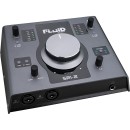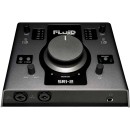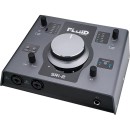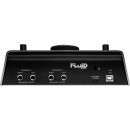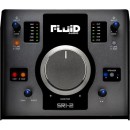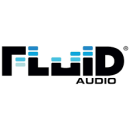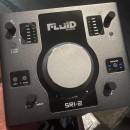Fluid Audio SRI-2 Audio Interface Review
- High-resolution 24-bit/192kHz audio conversion for professional-quality sound.
- Two Class-A microphone preamps with phantom power for clear and detailed recordings.
- Unique large metal volume knob for precise monitoring level adjustments.
- Balanced TRS outputs for connecting studio monitors.
- Zero-latency direct monitoring for seamless recording experience.
- USB bus-powered, eliminating the need for an external power supply.
- Rugged metal chassis for durability and portability.
- Compatible with both Mac and Windows operating systems.
Specifications and Features of the SRI-2
The Fluid Audio SRI-2 Audio Interface is a high-quality, versatile device designed for musicians, producers, and audio engineers looking for a reliable solution for recording and playback. This interface offers a compact and robust design, making it ideal for both home studios and mobile recording setups. With its sleek aluminum chassis, the SRI-2 not only looks professional but is also built to withstand the rigors of frequent use.
Equipped with two combo XLR/TRS inputs, the SRI-2 allows for the connection of various audio sources, including microphones and instruments. The preamps are renowned for their clarity and low noise, ensuring that your recordings capture every detail with precision. Additionally, the interface features high-resolution 24-bit/192kHz converters, providing exceptional audio fidelity for both recording and playback.
The SRI-2 also includes a large, easy-to-use volume knob and dedicated controls for input and output levels, offering intuitive operation. With its low latency performance and compatibility with both Windows and Mac systems, the Fluid Audio SRI-2 is an excellent choice for anyone seeking a reliable and high-performing audio interface for their creative projects.
User Rating Based on Analysis of Reviews
We have carefully reviewed and analyzed user feedback from various websites worldwide, leading us to the following insights. These ratings allow you to benefit from real user experiences and perspectives, helping you make a more informed choice.
Purchase Value
85% of users reported being satisfied with the purchase value of the Fluid Audio SRI-2 Audio Interface. They cited its competitive pricing in comparison to other interfaces with similar specifications, noting that it offers robust features and good sound quality, which makes it a great value for both beginners and seasoned audio professionals.
15% of users expressed dissatisfaction with the purchase value, primarily due to expectations for higher-end features that they felt were lacking. Some compared it to other products in a slightly higher price range, where they felt more advanced features justified the extra cost.
Sound Quality
90% of users were impressed with the sound quality offered by the Fluid Audio SRI-2. They praised its clear and accurate audio reproduction, which is essential for both music production and critical listening. Users noted that the preamps provided a clean sound with minimal noise and distortion.
10% of users found the sound quality less satisfying, mentioning occasional noise issues or comparing it to higher-end interfaces that offer even more pristine audio reproduction. Some users experienced problems with certain audio setups or felt that the sound didn't match their specific expectations.
Build Quality
88% of users appreciated the build quality of the Fluid Audio SRI-2, highlighting its sturdy construction and durable materials. Many users felt confident in the longevity of the product, noting that it felt solid and well-constructed, which is crucial for equipment that might be transported frequently.
12% of users were disappointed in the build quality, with some reporting issues such as loose knobs or connections. A few users noted that while the overall build was good, certain elements like the finish or button feel could be improved for a more premium experience.
Ease of Use
92% of users found the Fluid Audio SRI-2 interface easy to use. They appreciated the intuitive layout and user-friendly controls, which made setup and operation straightforward even for those new to audio interfaces. The simple integration with various DAWs also contributed to user satisfaction.
8% of users had difficulties with ease of use, mainly due to initial setup challenges or driver issues. Some users found the instructions insufficient or encountered compatibility problems with specific software or hardware setups.
Connectivity Options
80% of users were satisfied with the connectivity options available on the Fluid Audio SRI-2. They appreciated the inclusion of essential input and output ports, which allowed for seamless integration with their existing audio equipment and computers.
20% of users were dissatisfied with the connectivity options, citing a need for more diverse input/output ports or specific connectivity that was not available. Some users felt limited by the options provided, especially when compared to other interfaces in the same price range.
Driver Stability
78% of users were pleased with the driver stability of the Fluid Audio SRI-2, noting that it performed well with minimal crashes or interruptions during use. Users appreciated the reliable performance, which is crucial during live recording sessions or critical audio work.
22% of users experienced issues with driver stability, reporting occasional crashes or difficulties during installation. Some users encountered compatibility issues with their operating systems, which affected their overall experience and workflow.
Portability
84% of users found the Fluid Audio SRI-2 to be suitably portable, noting its compact size and lightweight design as beneficial for those needing to transport it between locations. Users appreciated its ease of carrying, which did not compromise on build quality.
16% of users felt that the portability could be improved, mentioning that while it was compact, the lack of a protective case or specific design elements made them cautious about carrying it without additional protection.
Design Aesthetics
86% of users were satisfied with the design aesthetics of the Fluid Audio SRI-2, appreciating its sleek and modern appearance that fits well in any studio setup. Users enjoyed the professional look that complemented the functionality of the device.
14% of users were less impressed with the design aesthetics, feeling that it lacked unique or standout features that would distinguish it from other interfaces. Some users desired more color options or a more personalized look to match their studio decor.
Durability
87% of users found the Fluid Audio SRI-2 to be durable, with many users reporting that it withstood regular use without showing signs of wear or malfunction. The robust construction was a key factor in their satisfaction, ensuring reliability over time.
13% of users had concerns about durability, with a few reporting early signs of wear or specific components that appeared less solid over time. Some users felt that certain parts, like knobs or jacks, did not inspire confidence in their long-term robustness.
Latency Performance
82% of users were satisfied with the latency performance of the Fluid Audio SRI-2, noting that it provided low-latency monitoring that was essential for recording and live performances. Users appreciated the minimal delay, which allowed for a smoother audio workflow.
18% of users experienced issues with latency, which they found problematic during recording sessions. Some users reported noticeable delays that affected their productivity, especially when working with more complex audio setups or software.
Customer Support
75% of users were satisfied with the customer support provided by Fluid Audio, highlighting responsive and helpful staff who addressed their queries and issues efficiently. Users appreciated the support resources available, which included documentation and online assistance.
25% of users were dissatisfied with customer support, citing long wait times or insufficient resolutions to their problems. Some users felt that the support team was not as knowledgeable as they expected, leading to frustration when dealing with technical issues.
Compatibility with DAWs
89% of users appreciated the compatibility of the Fluid Audio SRI-2 with a wide range of DAWs, allowing them to integrate it seamlessly into their existing audio production setups. Users valued the broad compatibility, which minimized setup time and technical hurdles.
11% of users faced compatibility issues with certain DAWs, which led to frustrations during installation or usage. Some users experienced glitches or needed additional configurations to achieve full functionality, impacting their overall satisfaction.
Control Features
83% of users were satisfied with the control features of the Fluid Audio SRI-2, appreciating the intuitive and easy-to-use controls that allowed for quick adjustments during recording sessions. Users found the control layout to be logical and user-friendly.
17% of users expressed dissatisfaction with the control features, feeling that more advanced or customizable controls would enhance their experience. Some users desired additional features that were standard on other interfaces they had used.
Preamp Quality
88% of users were pleased with the quality of the preamps in the Fluid Audio SRI-2, noting that they provided clean and clear amplification suitable for various recording needs. Users valued the low noise floor and high headroom offered by the preamps.
12% of users were less impressed with the preamp quality, mentioning that while adequate, they felt other interfaces offered better performance in this area. Some users experienced slight noise issues or felt the preamps could be more versatile.
Power Supply
81% of users were satisfied with the power supply options of the Fluid Audio SRI-2, appreciating that it could be powered via USB, which added convenience and reduced the need for additional cables or adapters.
19% of users expressed dissatisfaction with the power supply, noting that in some setups, the USB power was insufficient, leading to performance issues. Some users desired an external power option for more demanding situations or to ensure consistent performance.
Firmware Updates
79% of users were content with the availability and implementation of firmware updates for the Fluid Audio SRI-2, acknowledging that updates helped improve functionality and fix bugs over time. Users appreciated the commitment to maintaining and enhancing the product.
21% of users were dissatisfied with the firmware update process, citing difficulties during the update or lack of clear instructions. Some felt that updates were infrequent or did not address specific issues they were facing, impacting their overall experience.
Headphone Output Quality
85% of users were satisfied with the headphone output quality of the Fluid Audio SRI-2, noting that it provided clear and accurate monitoring suitable for both casual listening and professional mixing tasks.
15% of users found the headphone output quality lacking, mentioning that it could be improved in terms of volume or clarity. Some users compared it unfavorably to other interfaces with dedicated headphone amplifiers that offered better performance.
A/D Conversion Quality
91% of users were highly satisfied with the A/D conversion quality of the Fluid Audio SRI-2, praising its ability to deliver high fidelity audio conversion that was crucial for professional recordings. Users appreciated the clarity and precision offered by the converters.
9% of users had concerns regarding the A/D conversion quality, feeling that while good, it did not reach the level of more expensive interfaces. Some users noted minor artifacts or issues during complex audio processing tasks.
Instrument Input Quality
86% of users were satisfied with the instrument input quality on the Fluid Audio SRI-2, appreciating its ability to handle a variety of instruments with clarity and minimal distortion. Users noted the input's responsiveness and quality in capturing the nuances of their performances.
14% of users were dissatisfied with the instrument input quality, feeling that it could be improved for more demanding recording situations. Some users experienced noise or signal issues when connecting certain instruments, affecting their overall satisfaction.
Visual Feedback
77% of users appreciated the visual feedback provided by the Fluid Audio SRI-2, highlighting that the indicators and meters were clear and helpful during recording and monitoring. Users valued the ability to easily check levels and statuses.
23% of users were unsatisfied with the visual feedback, mentioning that it could be more detailed or easier to read in different lighting conditions. Some users desired more advanced visual indicators that are found in higher-end interfaces.
In the following sections, we delve into the detailed specifications of the Fluid Audio SRI-2 Audio Interface. Our comprehensive review will guide you through its features, highlighting both its advantages and potential drawbacks.
Pros:
- High-quality sound with 192kHz/24-bit resolution.
- Sturdy and attractive build with a sleek design.
- User-friendly interface with large control knobs.
- Balanced TRS outputs for professional connectivity.
- Low latency performance with direct monitoring feature.
Cons:
- Limited to only two input channels.
- No MIDI input/output ports.
- Lacks onboard DSP effects.
- Relatively higher price point compared to competitors with similar features.
General
| Channels of I/O | Analog: 2 Input / 2 Output at 192 kHz |
|---|---|
| Maximum Sampling Rate | 192 kHz / 24-Bit |
| Number of Microphone Inputs | 2 Preamps |
Channels of I/O: The SRI-2 audio interface features 2 analog inputs and 2 analog outputs, allowing for a straightforward connection to microphones, instruments, and other audio devices. This configuration is ideal for home studios or portable recording setups, providing the flexibility to capture multiple audio sources simultaneously while also enabling playback through speakers or headphones.Show More
Maximum Sampling Rate: The SRI-2 supports a maximum sampling rate of 192 kHz, which is a high standard for audio quality. This means that the device can capture and reproduce sound with exceptional clarity and detail, making it suitable for professional applications where fidelity is crucial. The 24-bit depth ensures a wide dynamic range, allowing for nuanced recordings that preserve the integrity of the original sound.
Number of Microphone Inputs: With 2 microphone preamps, the SRI-2 is equipped to handle two microphones simultaneously. These preamps are essential for amplifying the low-level signals from microphones to a usable level without introducing significant noise. This feature is particularly beneficial for recording vocals, instruments, or any audio source that requires precise capture, providing the flexibility needed for various recording scenarios.
Signal Processing
| Gain/Trim Range | Mic Inputs: +6 dB to +46 dB Hi-Z Inputs: +12 dB to +52 dB Line Inputs: -11 dB to +29 dB |
|---|
Gain/Trim Range refers to the adjustable amplification levels available for different input types on the SRI-2 Audio Interface. This feature is crucial for optimizing the audio signal received from various sources, ensuring that the levels are appropriate for recording or processing.Show More
For Mic Inputs, the gain range of +6 dB to +46 dB allows for significant amplification, making it suitable for capturing quiet vocal performances or instruments. The ability to add more gain helps in achieving a cleaner and more detailed sound without introducing excessive noise.
When it comes to Hi-Z Inputs, which are designed for high-impedance sources like electric guitars and basses, the gain range of +12 dB to +52 dB provides even more flexibility. This higher range is beneficial for accommodating the varying output levels of different instruments, ensuring that they can be recorded with the desired clarity and presence.
Lastly, the Line Inputs offer a gain range of -11 dB to +29 dB. This range is tailored for line-level signals, such as those from synths or other audio gear. The negative gain option allows for attenuation, which is useful when dealing with sources that might send out a stronger signal than desired, helping to prevent distortion and maintain audio fidelity.
Connectivity
| Analog Audio I/O | 2x Combo XLR-1/4" TRS Balanced/Unbalanced Mic/Line/Hi-Z Input 4x 1/4" TRS Balanced Monitor Output 1x 1/4" TRS Unbalanced Headphone Output |
|---|---|
| Phantom Power | 48 V, Selectable On/Off (Applied to All Inputs) |
| Digital Audio I/O | |
| Host Connection | 1x USB-B |
| Host Connection Protocol | USB 2.0 |
| MIDI I/O |
Analog Audio I/O refers to the physical audio connections available on the SRI-2 interface. This model features a total of two combo XLR-1/4" TRS inputs that can accommodate balanced or unbalanced microphone, line, or high-impedance signals. Additionally, it offers four balanced monitor outputs and one unbalanced headphone output. The variety of inputs and outputs allows for versatile connectivity, enabling users to connect a range of audio devices such as microphones, instruments, and studio monitors, which is essential for professional audio recording and monitoring.Show More
Phantom Power is a feature that provides a 48 V power supply to condenser microphones that require external power to operate. The SRI-2 allows users to easily toggle this feature on or off for all inputs. This is particularly important in studio environments where professional-grade microphones are used, as it ensures optimal performance and audio quality, providing flexibility for different recording situations.
Digital Audio I/O indicates the absence of digital audio connections such as optical or coaxial inputs and outputs on the SRI-2 interface. While some audio interfaces feature these digital options for enhanced connectivity and sound quality, the SRI-2 focuses on analog connections, which are sufficient for many users who primarily require straightforward audio I/O for recording and playback.
Host Connection specifies the type of connection used to interface the SRI-2 with a computer. The SRI-2 utilizes a USB-B connection, which is a common standard for audio interfaces. This connection type ensures compatibility with a wide range of computers and devices, making it easy for users to set up and start recording without the need for additional adapters or complex configurations.
Host Connection Protocol describes the data transfer standard used by the SRI-2 during communication with a computer. In this case, it employs USB 2.0, which provides a stable and efficient means of transmitting audio data. While newer interfaces may use USB 3.0 or higher for increased bandwidth, USB 2.0 is still widely used and supports high-quality audio streaming, making it a reliable choice for most recording applications.
MIDI I/O indicates that the SRI-2 does not include MIDI (Musical Instrument Digital Interface) connections, which are used for controlling and communicating with electronic musical instruments and software. While many modern audio interfaces feature MIDI capabilities for enhanced functionality, the SRI-2 is designed primarily for audio recording, catering to users who may not require MIDI support in their setup.
Performance
| Frequency Response | 20 Hz to 20 kHz ±0.1 dB |
|---|---|
| Maximum Input Level | Mic Inputs: +7 dBu Hi-Z Inputs: +4 dBu Line Inputs: +25 dBu |
| Maximum Output Level | Monitor Outputs: +6 dBFS Headphone Outputs: +12 dBu |
| Headphone Output Power | 75 mW per Channel into 32 Ohms |
| Impedance | Mic Inputs: 100 Ohms Hi-Z Inputs: 1 Megohm Line Inputs: 20 Kilohms Monitor Outputs: 75 Ohms Headphone Outputs: < 10 Ohms |
| Dynamic Range | Mic/Line/Hi-Z Inputs: 104 dBA Monitor Outputs: 102 dBA Headphone Outputs: 100 dBA |
| THD+N | Mic Inputs: 0.0016% Hi-Z Inputs: 0.0031% Line Inputs: 0.005% Monitor Outputs: 0.0014% Headphone Outputs: 0.006% |
| EIN | Mic Inputs: < -120 dBu A-Weighted |
The Frequency Response of an audio interface indicates the range of frequencies it can accurately reproduce, which for the Fluid Audio SRI-2 spans from 20 Hz to 20 kHz with a tolerance of ±0.1 dB. This range encompasses the full spectrum of human hearing, ensuring that both low bass tones and high treble notes are captured and played back with precision. A tighter tolerance means that the device will maintain a more consistent sound quality across its operational range, which is crucial for professional audio applications.Show More
Maximum Input Level specifies the highest signal level that can be captured by each type of input without distortion. For the SRI-2, the levels vary depending on the input type: +7 dBu for mic inputs, +4 dBu for Hi-Z inputs, and +25 dBu for line inputs. Higher maximum input levels allow for capturing louder signals without clipping, which is essential for maintaining audio integrity during recording sessions.
The Maximum Output Level reflects the peak signal that can be delivered through the outputs. The SRI-2 features +6 dBFS for monitor outputs and +12 dBu for headphone outputs. A higher output level is advantageous when driving studio monitors or headphones, ensuring that the playback is loud enough for critical listening without introducing distortion.
Headphone Output Power at 75 mW per channel into 32 Ohms indicates the amount of power the interface can provide to headphones. This level of power is typically sufficient for driving most studio headphones, ensuring clear and loud playback, which is especially important during monitoring sessions.
Impedance ratings for various inputs and outputs determine how much resistance the device offers to incoming signals and how well it interacts with connected equipment. For example, the mic inputs have an impedance of 100 Ohms, which is suitable for most microphones, while Hi-Z inputs at 1 Megohm cater to high-impedance instruments like electric guitars. Lower impedance in outputs like monitor outputs (75 Ohms) ensures better compatibility with studio monitors.
The Dynamic Range is a measure of the difference between the quietest and loudest sounds the interface can handle. The SRI-2 boasts a dynamic range of 104 dBA for mic/line/Hi-Z inputs and 102 dBA for monitor outputs. A greater dynamic range means that the interface can faithfully reproduce both very soft and very loud sounds, which is essential for high-quality recordings.
THD+N or Total Harmonic Distortion plus Noise is a measure of the distortion and noise that may be present in the audio signal. The SRI-2 features low values across its inputs and outputs, indicating that it maintains high fidelity and clarity in the audio it processes, which is vital for professional audio work.
Finally, the EIN or Equivalent Input Noise rating of less than -120 dBu A-Weighted for mic inputs indicates the noise level produced by the interface itself. A lower EIN value is preferable as it signifies less unwanted noise in the signal, allowing for cleaner recordings, especially when using sensitive microphones.
Digital Audio
| Sample Rates | 44.1 / 48 / 88.2 / 96 / 176.4 / 192 kHz |
|---|---|
| Bit Depths | 24-Bit |
| Latency | Zero-Latency Direct Monitoring |
| Sync Sources | Internal |
Sample Rates refer to the number of times audio is sampled per second, measured in kilohertz (kHz). The SRI-2 Audio Interface supports a range of sample rates from 44.1 kHz to 192 kHz. Higher sample rates allow for greater audio fidelity and detail, making them ideal for professional recording and production. For example, while 44.1 kHz is standard for CDs, rates like 96 kHz and 192 kHz are often preferred in high-resolution audio applications, providing a broader frequency response and enhanced sound quality.Show More
Bit Depths indicate the number of bits used to represent each audio sample. The SRI-2 operates at a bit depth of 24 bits, which is common in professional audio settings. A higher bit depth increases the dynamic range of the audio signal, allowing for more subtle nuances to be captured and reproduced. This results in cleaner audio with less noise and better overall quality, making it suitable for detailed mixing and mastering processes.
Latency is the delay between input and output in audio systems. The SRI-2 features Zero-Latency Direct Monitoring, which means that users can hear their input signal without any delay, allowing for a more natural and immediate recording experience. This is particularly beneficial for musicians and vocalists who need to monitor their performance in real time without distraction or timing issues.
Sync Sources determine how the audio interface synchronizes its clock with other devices. The SRI-2 has an Internal sync source, meaning it generates its own clock signal for timing purposes. Having a reliable internal clock is crucial for maintaining audio coherence across multiple devices, ensuring that recordings remain in sync and that playback is smooth, particularly in complex setups involving multiple instruments or tracks.
Audio Storage & Playback
| Memory Card Slot |
|---|
The Memory Card Slot feature refers to the capability of the audio interface to support external storage options through a memory card. In this case, the specification indicates that there is no memory card slot available on the Fluid Audio SRI-2. This means that users will not have the option to expand storage capacity or save audio files directly onto a memory card, which could limit portability and ease of access to recorded content.Show More
Without a memory card slot, users will need to rely on other methods for storage, such as connecting the audio interface to a computer or utilizing other devices for storing and managing audio data. This may not be a significant drawback for many users, especially if they primarily work in a studio environment, but it's an important consideration for those who require flexibility and mobility in their audio recording and production processes.
Compatibility
| OS Compatibility | macOS 10.6.4 or Later Windows 7 or Later |
|---|---|
| Mobile Device Compatibility | iPad |
| Required Hardware | Available USB 2.0 Port USB Cable (Included) Lightning to USB Adapter (Not Included) |
| Internet Connection | Required for Software/Driver Download |
OS Compatibility refers to the operating systems that support the Fluid Audio SRI-2 Audio Interface. Specifically, it is compatible with macOS versions 10.6.4 and later, as well as Windows 7 and later. This ensures that users on these platforms can effectively utilize the audio interface without any compatibility issues, allowing for seamless audio recording and playback.Show More
Mobile Device Compatibility indicates that the Fluid Audio SRI-2 can also be used with iPads, enhancing its versatility. This feature allows musicians and audio professionals to connect their audio interface to mobile devices for on-the-go recording and editing, making it a convenient choice for those who need a portable solution for their audio projects.
Required Hardware specifies the hardware components necessary for the SRI-2 to function properly. It requires an available USB 2.0 port for connection, and a USB cable is included for convenience. However, a Lightning to USB adapter is not included, which means users with newer iPads or iPhones may need to purchase this adapter separately to enable compatibility. This requirement is crucial for ensuring a proper connection between the audio interface and the device being used.
Internet Connection is essential for downloading the necessary software and drivers for the Fluid Audio SRI-2. This means that users must have internet access to install the software that enables the audio interface to communicate effectively with their computers or mobile devices. This step is critical for unlocking the full functionality of the interface and ensuring optimal performance during audio production tasks.
Power
| Power Requirements | USB Bus Power |
|---|
The Power Requirements specification indicates the power source needed for the Fluid Audio SRI-2 Audio Interface to operate. In this case, it utilizes USB Bus Power, which means that it draws power directly from the USB connection to your computer or laptop. This feature is particularly advantageous as it eliminates the need for an external power supply, making the device more portable and user-friendly.Show More
By relying on USB Bus Power, the SRI-2 benefits from a streamlined setup process. Users can quickly connect the audio interface to their devices without worrying about additional cables or power sources. This is especially useful for musicians and audio engineers who may work in various locations or need a compact solution for mobile recording. Overall, the power requirement enhances the convenience and versatility of the SRI-2 in various audio production environments.
Physical
| Anti-Theft Features | Kensington Security Slot |
|---|---|
| Weight | 2.3 lb / 1.0 kg |
The Anti-Theft Features section highlights the inclusion of a Kensington Security Slot, which is a standard security feature found on many electronic devices. This slot allows users to secure the audio interface to a fixed object using a compatible lock. By preventing theft, it provides peace of mind, particularly in environments where the device may be left unattended, such as studios or public spaces.Show More
Regarding the Weight specification, the SRI-2 Audio Interface weighs 2.3 lb (1.0 kg). This lightweight design makes it highly portable and easy to transport, which is essential for musicians and audio professionals who often work in different locations. A manageable weight ensures that the device can be easily carried without compromising durability or functionality.
Packaging Info
| Package Weight | 2.87 lb |
|---|---|
| Box Dimensions (LxWxH) | 11.6 x 7.8 x 3.8" |
The Package Weight of 2.87 lb indicates the total weight of the Fluid Audio SRI-2 Audio Interface when packaged. This weight is important for shipping and handling purposes, as it helps users estimate shipping costs and determine the ease of transport. A lighter package often means more convenient portability, which is a valuable aspect for musicians and audio professionals who may need to move their equipment frequently.Show More
The Box Dimensions (11.6 x 7.8 x 3.8 inches) provide the physical size of the packaging. This measurement is crucial for understanding how much space the device will occupy in a bag or on a shelf. Additionally, knowing the dimensions can assist in planning for storage and transportation, ensuring that the audio interface fits comfortably in the user's gear setup. Smaller dimensions generally suggest a more compact design, which can be beneficial for mobile recording setups.
Customer Images
Customer Questions
How do I install the Fluid Audio SRI-2 drivers on my computer?
To install the Fluid Audio SRI-2 drivers, visit the official Fluid Audio website and navigate to the SRI-2 product page. Download the appropriate driver for your operating system (Windows or macOS). Once downloaded, run the installer and follow the on-screen instructions to complete the installation. Restart your computer after the installation is complete.
Why is there no sound coming from my speakers when using the SRI-2?
Ensure that the SRI-2 is selected as the default audio device in your computer's sound settings. Check that the speakers are properly connected to the SRI-2 outputs. Also, verify that the volume on both the SRI-2 and your speakers is turned up. Make sure you have the latest drivers installed.
How can I connect the SRI-2 to my DAW software?
Open your DAW software and navigate to the audio settings or preferences. Set the audio input and output to 'Fluid Audio SRI-2'. Make sure you are using the correct sample rate and buffer size settings. Refer to your DAW's manual for specific instructions on selecting an audio interface.
What should I do if the SRI-2 is not being recognized by my computer?
Try a different USB cable and port to ensure the issue isn't with the connection. Check if the SRI-2 is listed in your computer's device manager (Windows) or audio MIDI setup (macOS). If not, reinstall the drivers. If the problem persists, consider updating your operating system and checking for firmware updates on the Fluid Audio website.
Can I use the SRI-2 with my iPad or iPhone?
Yes, you can use the SRI-2 with an iPad or iPhone using a Lightning to USB adapter. Ensure that your iOS device supports USB audio interfaces and that you have the appropriate app to handle audio recording or playback. You might need to use a powered USB hub to provide adequate power to the SRI-2.
How do I switch between headphone and speaker monitoring on the SRI-2?
The SRI-2 features a Monitor A/B switch on the front panel. To switch between headphone and speaker monitoring, simply press the button to toggle between the two. Make sure the headphones or speakers are properly connected to the SRI-2.
What is the best way to update the firmware on my SRI-2?
Visit the Fluid Audio website and download the latest firmware update for the SRI-2. Follow the provided instructions carefully to ensure a successful update. Usually, this involves connecting the SRI-2 to your computer via USB and running the firmware update utility.
Why am I experiencing latency issues with the SRI-2?
Latency issues can often be resolved by adjusting the buffer size in your DAW's audio settings. Lower the buffer size for reduced latency, keeping in mind that this may increase CPU usage. Ensure you have the latest drivers installed, and consider optimizing your computer for audio performance.
How do I set up the SRI-2 for recording vocals?
Connect your microphone to one of the SRI-2's XLR inputs. Ensure that phantom power is enabled if your microphone requires it. Adjust the gain knob to achieve a good input level without clipping. In your DAW, select the SRI-2 as your input source and create a new track for recording. Arm the track and start recording.
What should I do if the SRI-2 produces a humming or buzzing noise?
Check all cables and connections to ensure they are securely connected and not damaged. Make sure the SRI-2 is not placed near power sources or other electronic devices that might cause interference. Try using balanced cables for connections to reduce the chance of noise. If the issue persists, contact Fluid Audio support for further assistance.
